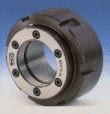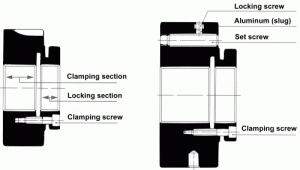Contact us today:

(847) 934-4500
tdaro@bernardandcompany.com

Contact us today:
(847) 934-4500
tdaro@bernardandcompany.com

Bertsche iJet waterjet deburring system built for Linamar combines waterjet deburring with part cleaning for one inline system.
Canadian automotive part supplier realizes significant gains with Bertsche-designed multi-function system in its plant
With factory floor space at a premium and capital equipment funds scarce, Linamar, a Tier One Canadian automotive part supplier, turned to Bertsche Engineering recently for an all-in-one part deburring, final rinse and drying solution.
Typically, complex machined automotive parts with multiple intersecting holes require feature-specific part deburring to insure that parts are burr-free. After deburring, parts also need a final cleaning/washing to insure removal of microscopic particles that might adversely affect performance. They are then preserved with a rust or oxidation inhibitor and dried for shipment (transport) to be assembled. Usually, this involves separate pieces of equipment linked by conveyors or robots to transport parts to each machine.
To solve the problem of densely filled factory floor space, Bertsche Engineering developed a machine that handles all these processes in one machine, in one deburring cycle. The machine takes oil and chip contaminated parts, previously machined on CNC milling centers and mill/turn machines, then selectively deburrs critical features using high pressure water, blasting chips out of internal cavities, knocking off all feather-edge burrs and fan washing the outside of the part, using a CNC for full cycle control.

Close-up shows parts infeed and outfeed station, where considerable space savings were realized by the customer, Linamar, a major Canadian Tier One automotive parts supplier.
This process is accomplished by a series of rotating lance nozzles that probe small diameter internal holes in order to blast feather edge burrs clean at intersection points and wash chips out of dead-end passages. External features are then blasted with a series of direct nozzles that release up to 10,000 psi of water at the burr while tracing the part edges. The part is then washed with high-pressure rotating fan nozzles. Note: When required, additional mechanical wire and filament brush tooled deburring stations can be incorporated into the Bertsche system to mechanically remove burrs.
The same machine moves the deburred part to an agitated wash and rinse station, where the part is rinsed, cleaned and preserved with an aqueous rust inhibitor (providing up to 24-day protection) and is finally dried. The part is then ready for final assembly.

Close-up shows parts being indexed over high-pressure (10,000 psi) waterjet nozzles for full wash cycle and rust-inhibiting aqueous coating process
For more information on this application, please contact:
BERTSCHE ENGINEERING CORPORATION www.bertsche.com
PR agency contact: Tim Daro Bernard & Company www.bernardandcompany.com
Release: BERTSCHE ENGINEERING CORPORATION
Date: December 28, 2009
 Improves efficiency and bearing reliability on industrial compressors and other applications; positive locking WITHOUT washers and keys; supports extreme thrust loads
Improves efficiency and bearing reliability on industrial compressors and other applications; positive locking WITHOUT washers and keys; supports extreme thrust loads
Advanced Machine & Engineering Co., (AME) Rockford, IL provides its unique Spieth locknuts for accurate rotor positioning and reliable thrust bearing retentionon compressors, shafts, spindles and other industrial/commercial applications, in a unique engineering achievement.
In a compressor application, for example, the locknut can play a key role in establishing the clearance between the rotor and the compressor housing, where too little clearance causes seizure, while too much reduces compressor efficiency, due to leakage around the rotor body.
While the standard Spieth locknut configuration had considerable appeal for the application, several design refinements were deemed highly beneficial for this application. “We liked the positive locking feature without washers and keys, plus the locknut’s ability to support extreme thrust loads by providing full 360º contact around the thread flanks,” according to one application engineer contacted for this story.
Key features that led to one compressor manufacturer’s selection of the Spieth product from AME included:
The full circumference contact of the Spieth locknut was designed to ensure the locknut would not back off, even when subjected to extreme shock loads. It further aligns its contact face with either a zero runout or, as needed, it can be adjusted to suit the inaccuracies of the in-line connecting components, thus compensating for minor errors of parallelism due to the stack-up of mating parts. Uneven bearing loading is thus compensated and its impact minimized.

The basic design of the Spieth adjustable locknut involves two axially arranged radial grooves, one from the outside and one from the inside, which result in a diaphragm-like cross-section to give the locknut a predetermined axial elasticity. The internal groove divides the locknut into a clamping and a locking section. Depending on the nut size, multiple axially arranged socket head set screws are used to clamp the sections together. This eliminates the thread flank clearance between the rotor and the locknut, allowing for shockproof clamping.
In installing the locknuts, a consistent tool torque setting was found sufficient to achieve parallel locknut body and threads. Thus, the face of the thread flank and centerline of the shaft were always in ideal alignment. This was done to provide a square thrust collar for thrust bearing reliability and rotor positioning.

Other applications for Spieth locknuts typically include shaft and spindle retention on bearings, where displacement, axial preload and clearance issues are critical. The unique design of this locknut ensures no back-off, even when subjected to extreme shock loads. In machine tool and heavy equipment use, for example, spindle runout due to uneven bearing loads can be eliminated, due to the full 360º contact around thread flanks. Spieth heavy-duty locknuts can be used with needle and roller thrust bearings, plain thrust bearings or taper roller bearings on ballscrews, worm drives, bevel gears and other high-thrust carrying components.
For technical questions on this article, please contact Shane Hatfield (shane@ame.com) at AME.
Advanced Machine & Engineering Co., is a manufacturer located in Rockford, IL, serving the Machine Tool Industry with precision components and accessories, including spindle interface components, workholding devices, and, through our sister company, Hennig, machine enclosures, chip removal and filtration systems. The Fluid Power – Safety markets are served with cylinder rod locks and safety catcher devises; and the Production Saw market with our Amsaw carbide saw machines and Speedcut blade products. AME has manufacturing partners and customers around the world and across the U.S. To learn more, visit www.ame.com.
Hennig, Inc. design and produces custom machine protection and chip/coolant management products for state-of-the-art machine tools. Hennig products are designed to protect against corrosion, debris and common workplace contaminants. Manufacturing facilities located in the U.S., Germany, Brazil, India, Japan, China and South Korea. Repair centers are located in Machesney Park, IL; Chandler, OK; Livonia, MI; Blue Ash, OH; Mexico City, Mexico and Saltillo, Mexico. To learn more, visit www.hennigworldwide.com.
For more information, contact:
Tim Waterman
ADVANCED MACHINE & ENGINEERING CO.
2500 Latham St.
Rockford, IL 61103
Phone: 815-316-5277
Fax: 815-962-6483
E-mail: info@ame.com
No. 1018 is an electrically-heated, 500º F (~260ºC) three-zone belt conveyor oven from Grieve, currently used for drying ceramic parts. Workspace dimensions are 18” wide x 40’ deep x 18” high. 180 KW (60 KW per zone) are installed in Incoloy-sheathed tubular heating elements, while three 3-HP recirculating blowers (total 12,600 CFM) provide vertical downward airflow to the workload. The oven was split into three sections for shipment.

The unit contains a 12” wide, 1/2” stainless steel flat wire conveyor belt with 1/3-HP motor drive, variable from 2 to 30 inches per minute and has a 30” long open belt loading zone and a 60” long open unloading zone.
This Grieve conveyor oven features 4” insulated walls, aluminized steel exterior and Type 304, 2B finish stainless steel interior, three independent doors for access to the workspace, three 325 CFM powered forced exhausters and the unit was built to NEMA 12 electrical standards. It has disposable fresh air filters in each zone, including photohelic pressure gauges with alarms.
Controls onboard No. 1018 include SCR power controllers and independent recirculated airflow and temperature controls for each of three 162” insulated heat zones.
For more information, please contact: THE GRIEVE CORPORATION, 500 Hart Road, Round Lake, Illinois 60073-2835 USA. Phone: (847) 546-8225. Fax: (847) 546-9210. Web: www.grievecorp.com. Email: sales@grievecorp.com. Attention: Frank Calabrese.
NEWS RELEASE: THE GRIEVE CORPORATION
DATE: November 23, 2009.
Agency contact: Tim Daro 847-934-4500